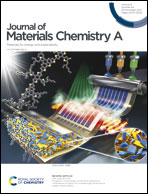D–A–π–A organic sensitizer surface passivation for efficient and stable perovskite solar cells†
Abstract
Organic–inorganic hybrid lead perovskite films are crucial in perovskite solar cells (PSCs). However, a solution deposition process rendered a polycrystalline feature to perovskite films with a large number of ionic defects on the surface and grain boundaries, which will serve as non-radiative recombination centers, limiting the photovoltaic performance of PSCs. In this work, D–A–π–A-type organic sensitizers (MM-3 and MM-4) with a quinoxaline moiety were employed to enhance light harvesting and reduce the trap states of perovskite films. MM-4 of the D–A–π–A system dye has a more coplanar structure because it contains a thiophene π-bridging moiety, which would facilitate electron transfer in molecules, enrich electron density on the terminal carboxyl group and provide good condition for coordination with undercoordinated Pb2+, resulting in the reduction of trap states and suppression of the non-radiative recombination in perovskite films. Therefore, there was a significant increase in the open-circuit voltage (VOC) from 1.02 to 1.08 V, and PCE increased from 18.91% to 20.31%. Furthermore, the long alkyl chains will enhance the hydrophobicity of perovskite films, and PSCs passivated by MM-4 exhibited excellent stability without encapsulation. It can maintain about 92% of initial PCE under 15 ± 5% relative humidity after 70 days and over 77% of initial PCE under 50–60% relative humidity after 550 h. We demonstrate that the D–A–π–A sensitizer can be another passivator for effectively passivating the trap states, which significantly improve the PCE and device durability.



 Please wait while we load your content...
Please wait while we load your content...